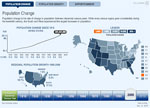Congressional Apportionment
You are here: Census.gov › People and Households › Congressional Apportionment
Congressional Apportionment Main
The fundamental reason for conducting the decennial census of the United States is to apportion the members of the House of Representatives among the 50 states. A state's resident population consists of those persons "usually resident" in that state (where they live and sleep most of the time). A state's apportionment population is the sum of its resident population and a count of overseas U.S. military and federal civilian employees (and their dependents living with them) allocated to the state, as reported by the employing federal agencies.
The Amazing Apportionment Machine Video
 Through animation, the U.S. Census Bureau helps explain how the apportionment formula is used to ensure equal representation for all, just like the Founding Fathers planned.
Through animation, the U.S. Census Bureau helps explain how the apportionment formula is used to ensure equal representation for all, just like the Founding Fathers planned.


 Facebook
Facebook Twitter
Twitter Flickr
Flickr YouTube
YouTube